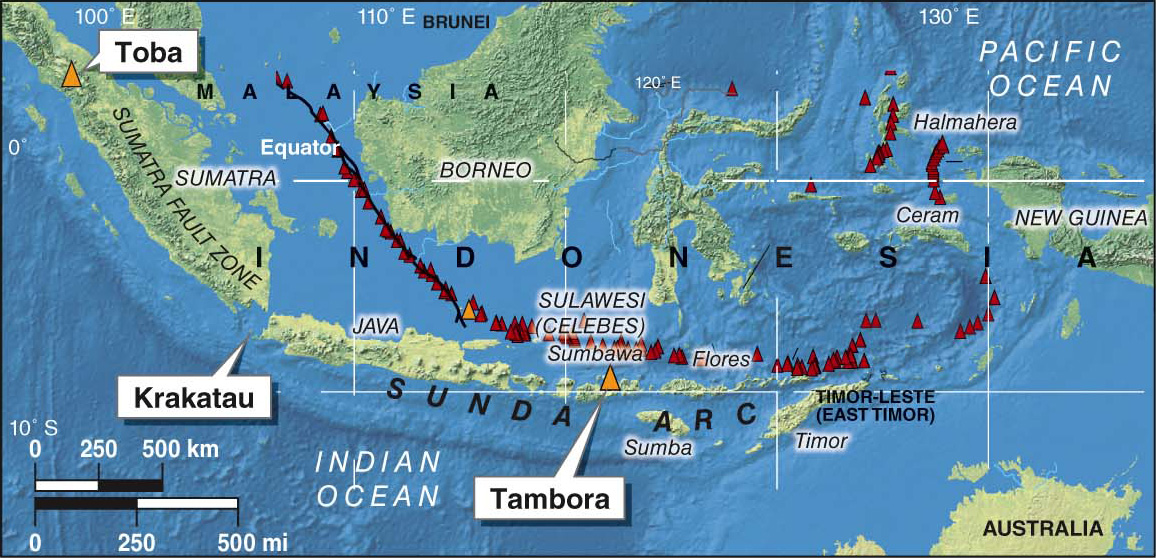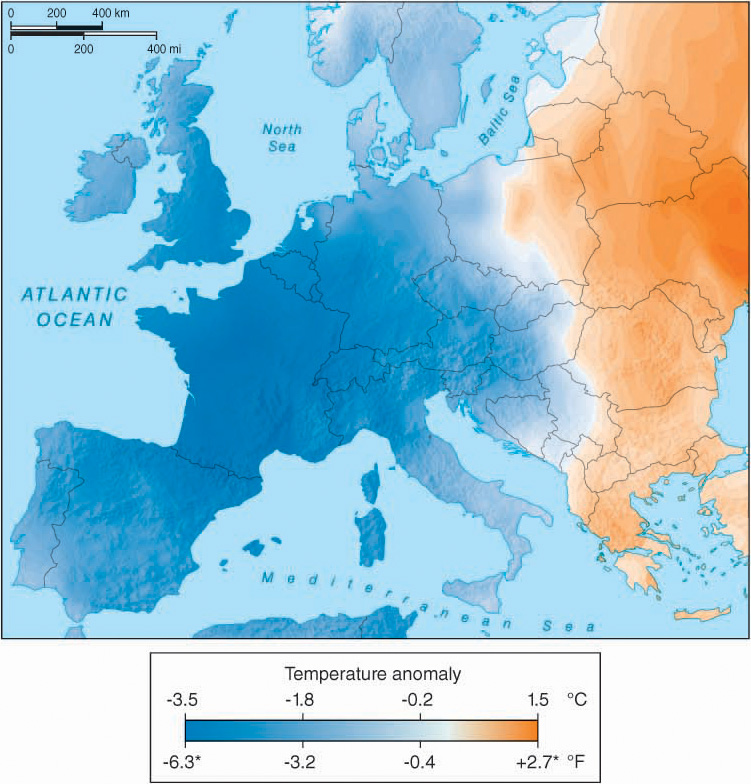14.5 The World’s Deadliest Volcano

Assess the potential links between large volcanic eruptions, Earth’s physical systems, and people.
The Gothic horror novel Frankenstein and physical geography are linked in a surprising way. The novel’s author, Mary Shelley, was vacationing on Lake Geneva in Switzerland in the summer of 1816. The weather was uncharacteristically cold, gloomy, and stormy, so her vacation was spent confined indoors with her husband and friends. They held a contest writing ghost stories to see who could best express how they felt about their miserable situation. Shelley won, and Frankenstein was born. Little did Shelley know that her inspiration was due to the eruption of Tambora, a volcano 12,300 km (7,600 mi) away on the island of Sumbawa, east of Java, the year before.
Tambora (elevation 2,850 m or 9,350 ft) is part of the Sunda Arc, the volcanic island arc that makes up part of Indonesia. Subduction of the Indo-

Figure 14.32
Krakatau’s most recent big eruption was in 1883. It was a VEI 6 eruption that killed over 36,000 people. Toba’s eruption about 73,000 years ago was one of the largest known volcanic eruptions in Earth’s history. Scientists estimate that it had a magnitude of VEI 8 and believe that it caused significant climate change worldwide as ash veiled the Sun and cooled the planet for as much as several centuries. Tambora’s most recent big eruption, in 1815, holds the dubious distinction of causing the greatest known human death toll of any volcanic eruption.
The Waking Giant
In 1812, after centuries of sleep, Tambora awoke with a series of blasts that could be heard over hundreds of miles. These massive detonations culminated in an 1815 eruption of colossal -proportions.
At about 7:00 p.m. on April 10, 1815, a VEI 7 eruption occurred that could be heard as far away as South Asia, some 2,600 km (1,600 mi) away. Similar eruptions thundered during the night and into the next day. Mount Tambora was blown apart by the force of these blasts and was reduced in height by almost 1.5 km (1 mi). A column of ash punched into the stratosphere and reached an altitude of 43 km (27 mi), nearly to the base of the mesosphere. Thick ash rained down to the north (Figure 14.33). Up to 100,000 people died in the immediate vicinity of Tambora, both directly in pyroclastic flows and indirectly in tsunamis, as well as from starvation resulting from crop failure.

Figure 14.33
Today, Tambora continues to show signs of life. In August 2011, the mountain erupted small amounts of ash into the atmosphere. Earthquakes are common, indicating shifting magma and gas in the magma chamber. Surprisingly, few of the 3,000 or so people living on the flanks of the volcano today even know about the 1815 eruption and the loss of life that occurred. Some 130 million people now live on the nearby island of Java. A similar eruption today would bring catastrophic loss of life. Scientists are carefully monitoring Tambora for signs of reawakening.
469
Tambora’s Wide Reach
Stratovolcano eruptions ranked VEI 7 put more than 100 km3 (24 mi3) of ash, as well as an estimated 400 million tons of sulfur gases, into the atmosphere. When sulfur combines with water, it creates droplets of sulfuric acid. These droplets can remain suspended in the stratosphere for several years. The ash and sulfuric acid droplets reflect and absorb solar radiation in the stratosphere and cool Earth’s surface (see Section 6.2). Climatologists have coined the term volcanic winter to describe the cooling effects of large volcanic eruptions.
The Year without a Summer
The year 1816 was nicknamed the Year without a Summer or Eighteen-
Question 14.11
What was the “Year without a Summer”?
The year 1816 was named the “Year without a Summer” in eastern North America because of the cooling effects of aerosols from the Tambora eruption in the stratosphere.

Figure 14.34
North America, Europe, Argentina, South Africa, India, and China all experienced unusually cold summers in 1816. The average summer temperature in the northeastern United States was about 3°C to 6°C (5°F to 10°F) below average. There was snow in New England in every month of the year in 1816.
Unfortunately, Tambora’s effects on humanity were not limited to unseasonable snowstorms. Tambora triggered crop failure and disease outbreaks and changed rainfall patterns as well.
Crop Failure
Crop failure was widespread, leading to hunger and starvation in New England, the United Kingdom, Germany, and across much of Europe. There is almost no vintage 1816 wine from Europe because the grape harvests were destroyed by the low temperatures. New England experienced an unusual number of killing frosts and record low agricultural harvests during the summer of 1816.
Many European cities had already been shaken politically by the Napoleonic Wars, and the food shortages after the eruption of Tambora sparked social unrest, riots, arson, and looting. Britain even stopped collecting income taxes in 1816 in response to food shortages and a hungry and volatile populace.
470
Typhus Outbreak
Tambora is blamed for a typhus epidemic between 1816 and 1819 in Europe. It is thought to have started in Ireland, spread to England, and then moved south into continental Europe. Some 65,000 people lost their lives in this epidemic. People were vulnerable to this disease because of the poor nutrition resulting from crop losses caused by the eruption.
Indian Monsoon
Tambora’s aerosols in the upper atmosphere are thought to have changed the Asian monsoon rainfall pattern (see Section 4.4), causing widespread crop failures, severe hunger, and greater susceptibility to diseases. Cholera outbreaks and famine occurred in 1816 in the Bengal region of eastern India because rainfall from the monsoon came late and heavy, causing severe flooding. The cholera outbreak spread into parts of Europe, China, and Russia as people traveled between regions and transmitted the disease.
The atmosphere, biosphere and people, lithosphere, and hydrosphere are all connected in ways that are sometimes challenging to see until an event like Tambora reveals these connections.
471